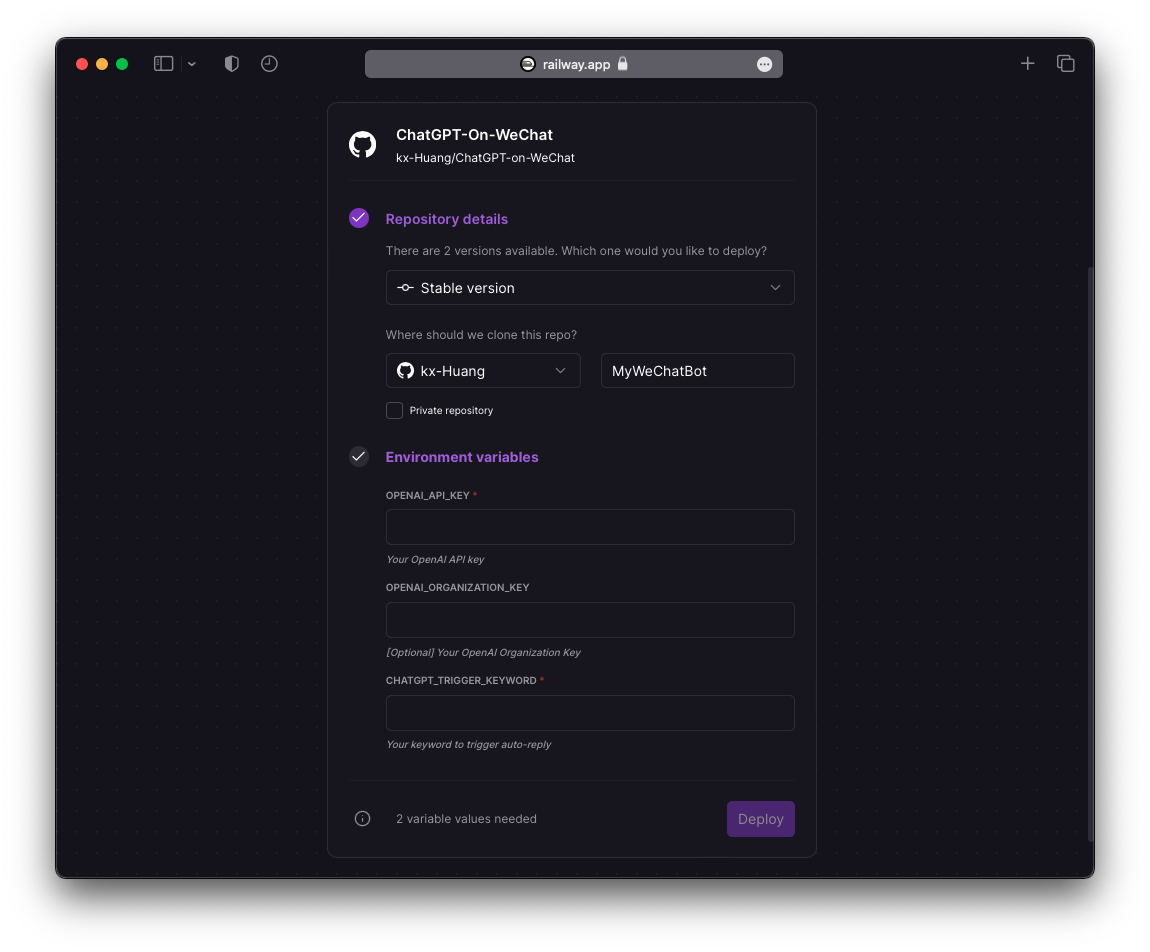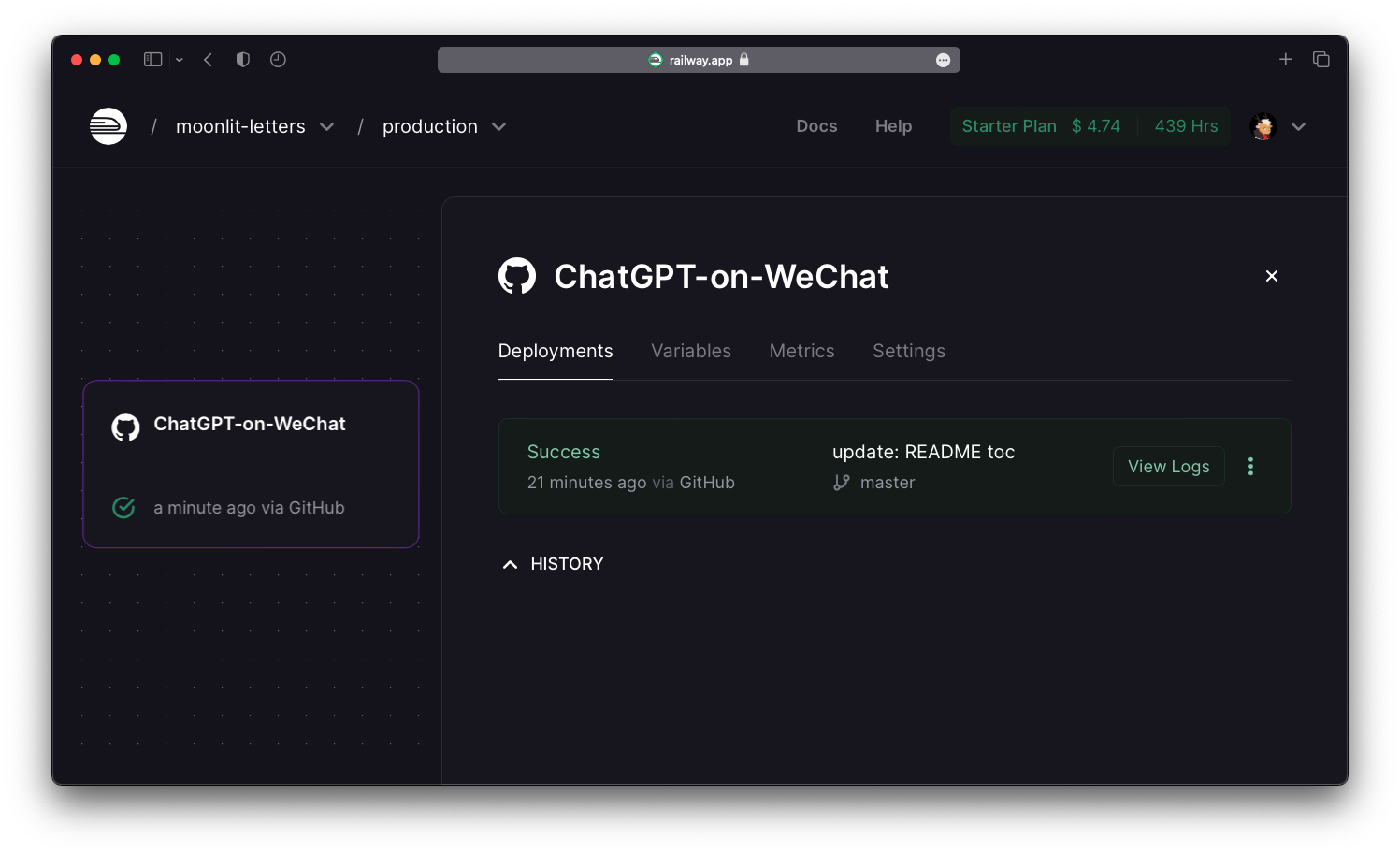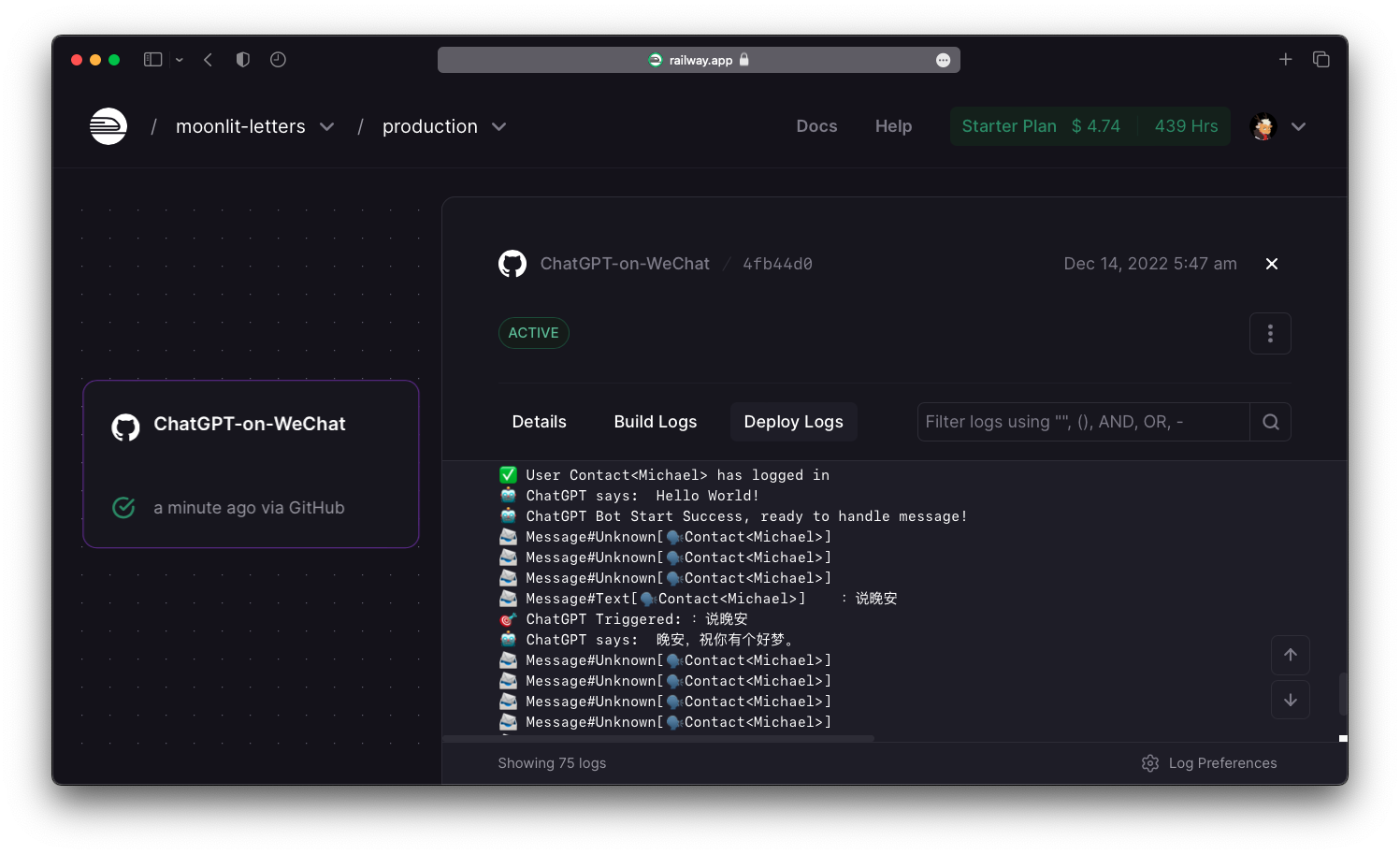🤖️ Turn your WeChat into ChatGPT within only 2 steps! 🤖️
This project is implemented based on this amazing project that I contibuted before, with Wechaty SDK and OpenAI API, we achieve:
- fast and robust connection to a set of AI models with different features, typically
gpt-3.5-turbowhich powersChatGPT - stable and persistent deployment on cloud servers
Railway
- 1. How to Deploy this Bot?
- 2. Any Fancy Advanced Settings?
- 3. Common Errors and Troubleshooting
- 4. How to Contribute to this Project?
- Thanks for your support!
You can deploy in local or on cloud, whatever you want.
The deploy on cloud method is recommended.
openaiApiKeycan be generated in the API Keys Page in your OpenAI accountopenaiOrganizationIDis optional, which can be found in the Settings Page in your Open AI account
You can copy the template config.yaml.example into a new file config.yaml, and paste the configurations:
openaiApiKey: "<your_openai_api_key>"
openaiOrganizationID: "<your_organization_id>"
chatgptTriggerKeyword: "<your_keyword>"Or you can export the environment variables listed in .env.sample to your system, which is a more encouraged method to keep your OpenAI API Key safe:
export OPENAI_API_KEY="sk-XXXXXXXXXXXXXXXXXXXXXXXXXXXXXX"
export OPENAI_ORGANIZATION_KEY="org-XXXXXXXXXXXXXXX"
export CHATGPT_TRIGGER_KEYWORD="机器人你好:"Please note:
chatgptTriggerKeywordis the keyword which can trigger auto-reply:- In private chat, the message starts with it will trigger auto-reply
- In group chat, the message starts with
@Name <keyword>will trigger auto-reply
chatgptTriggerKeywordcan be empty string, which means:- In private chat, every messages will trigger auto-reply
- In group chat, only "@ the bot" will trigger auto-reply
- Setup Docker Image
docker build -t openai-on-wechat .- Setup Docker Container
docker run -v $(pwd)/config.yaml:/app/config.yaml openai-on-wechatOnce you deploy the bot successfully, just follow the terminal or Logs in Docker container prompt carefully:
- Scan the QR Code with mobile WeChat
- Click "Log in" to allow desktop login (where our bot stays)
- Wait a few seconds and start chatting!
🤖 Enjoy your powerful chatbot! 🤖
Click the button below to fork this repo and deploy with Railway!
Fill in the following blanks:
- Your forked repo name (can be any name you like)
- Choose make it private or not (also up to you)
- Environment variables (for how to get OpenAI API keys, please refer to 1.1.1 Get your OpenAI API Keys
Please note:
Make sure the environment variables are set in RailWay instead of writing directly in config.yaml. It's really NOT recommended to implicitly write out your OpenAI API Key in public repo. Anyone with your key can get access to the OpenAI API services, and it's possbile for you to lose money if you pay for that.
The deploy process is automatic. It may take a few minutes for the first time. As you see the Success, click the tab to see the details. (which is your secret WeChat console!)
Click Deply Logs and you will see everything is setting up, wait for a QR Code to pop up. Scan it as if you are login to your desktop WeChat, and click "Log in" on your mobile WeChat.
Finally, everything is good to go! You will see the logs when people sending you messagem, and whenever the chatbot is auto-triggered to reply.
🤖 Enjoy your powerful chatbot! 🤖
When the OpenAI API encounters some errors (e.g. over-crowded traffic, no authorization, ...), the chatbot will auto-reply the pre-configured message.
You can change it in src/chatgpt.js:
const chatgptErrorMessage = "🤖️:ChatGPT摆烂了,请稍后再试~";You can change whatever OpenAI Models you like to handle task at different capability & time-consumption trade-off. (e.g. model with better capability costs more time to respond)
Currently, we use the latest gpt-3.5-turbo model. According to OpenAI doc,
ChatGPT is powered by
gpt-3.5-turbo, OpenAI’s most advanced language model.
Also, for the same model, we can configure dozens of parameter (e.g. answer randomness, maximum word limit...). For example, for the temperature field:
Higher values like 0.8 will make the output more random, while lower values like 0.2 will make it more focused and deterministic.
You can configure all of them in src/chatgpt.js:
chatgptModelConfig: object = {
// this model field is required
model: "gpt-3.5-turbo",
// add your ChatGPT model parameters below
temperature: 0.8,
// max_tokens: 2000,
};For more details, please refer to OpenAI Models Doc.
You can change whatever features you like to handle different types of tasks. (e.g. complete text, edit text, generate code...)
Currently, we use createChatCompletion() powered by gpt-3.5-turbo model, which:
take a series of messages as input, and return a model-generated message as output.
You can configure in src/chatgpt.js:
const response = await this.openaiApiInstance.createChatCompletion({
...this.chatgptModelConfig,
messages: inputMessages,
});For more details, please refer to OpenAI API Doc.
You can add your own task handlers to expand the ability of this chatbot!
In src/chatgpt.ts ChatGPTBot.onCustimzedTask(), write your own task handler:
// e.g. if a message starts with "Hello", the bot sends "World!"
if (message.text().startsWith("Hello")) {
await message.say("World!");
return;
}-
Error Log:
uncaughtException AssertionError [ERR_ASSERTION]: 1 == 0 at Object.equal (/app/node_modules/wechat4u/src/util/global.js:53:14) at /app/node_modules/wechat4u/src/core.js:195:16 at processTicksAndRejections (node:internal/process/task_queues:96:5) { code: 2, details: 'AssertionError [ERR_ASSERTION]: 1 == 0\n' + ' at Object.equal (/app/node_modules/wechat4u/src/util/global.js:53:14)\n' + ' at /app/node_modules/wechat4u/src/core.js:195:16\n' + ' at processTicksAndRejections (node:internal/process/task_queues:96:5)' } -
Solution:
- Solution:
- Before deployment, read the trigger conditions in 1.1.2 Configure Environment Variables
- After deployment, check the console logs for following lines:
- 🎯 Trigger keyword in private chat is:
<keyword> - 🎯 Trigger keyword in group chat is:
@Name <keyword>
- 🎯 Trigger keyword in private chat is:
You can raise some issues, fork this repo, commit your code, submit pull request, and after code review, we can merge your patch. I'm really looking forward to develop more interesting features!






